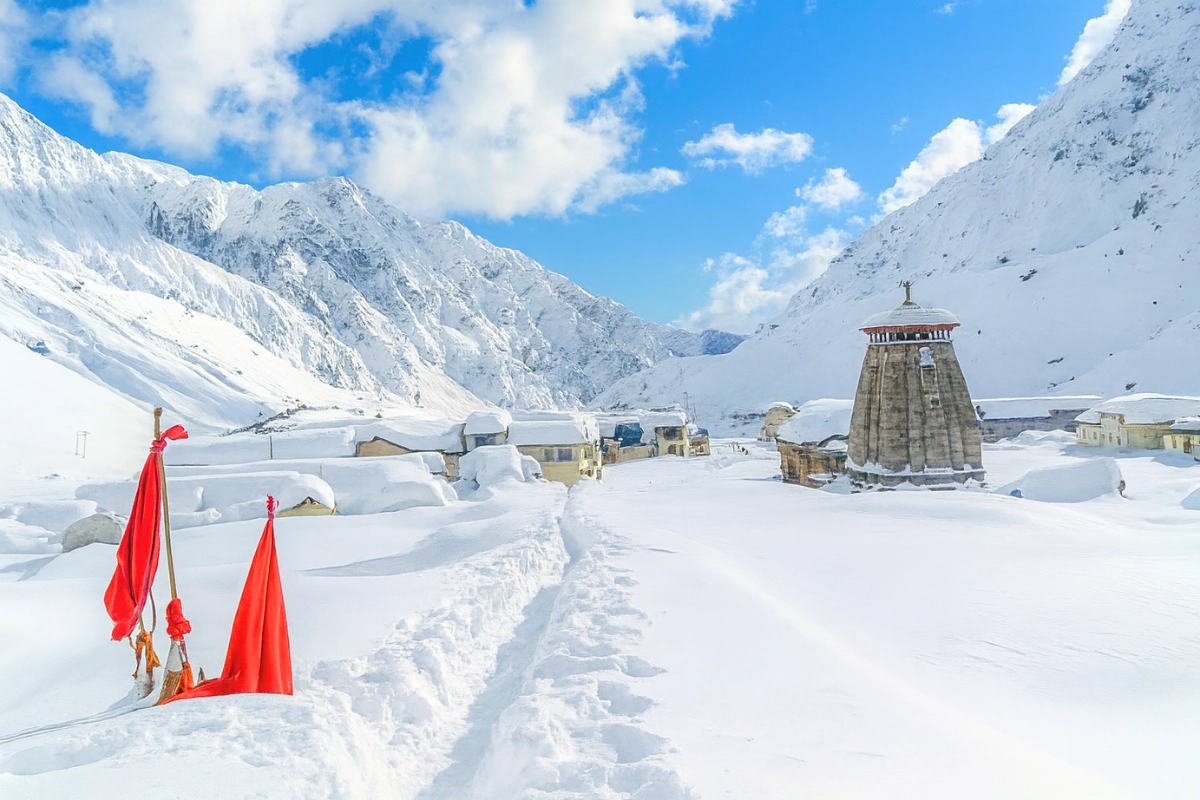
Published On - Nov 14, 2025
Updated On - Nov 14, 2025
10 min
First Winter’s Snowfall in Kedarnath
Nestled in the majestic Garhwal Himalayan range, Kedarnath is a place of spiritual significance and natural beauty. With the recent closing of the Kapaat, or doors, of the Kedarnath Temple for the winter season, the region has already experienced its first winter snowfall in Kedarnath. This enchanting event marks the beginning of a serene yet challenging period for this sacred area.
The first winter snowfall in Kedarnath after the closing of the Kapaat is a poignant reminder of the natural cycles that govern this sacred landscape. While the temple doors are closed, the spirit of Kedarnath remains alive in the hearts of devotees and the community that upholds its traditions.
The winter months, though challenging, allow for a period of rest and renewal, both for the land and its people. As the snow blankets Kedarnath, it preserves the sanctity and beauty of this hallowed place, awaiting the return of pilgrims with the arrival of spring.
Kedarnath snowfall is not merely a weather event; it is a testament to the enduring spirit of a land where spirituality and nature are intertwined. Whether viewed from afar or experienced in person, it is a reminder of the majesty and mystery of the Himalayas.
The Significance of Kedarnath
Nestled in the majestic Garhwal Himalayan range, Kedarnath is a place of spiritual significance and natural beauty. With the recent closing of the Kapaat, or doors, of the Kedarnath Temple for the winter season, the region has already experienced its first winter snowfall in Kedarnath. This enchanting event marks the beginning of a serene yet challenging period for this sacred area.
Kedarnath is one of the Char Dhams and holds immense religious importance for Hindus. Every year, thousands of pilgrims undertake the arduous journey to seek blessings at the Kedarnath Temple, dedicated to Lord Shiva. The temple remains open to devotees from late April to early November, after which the Kapaat is ceremoniously closed for the harsh winter months. During this time, the deity is moved to Ukhimath, where it is worshiped until the temple reopens in the spring.
The Beauty of Winter’s First Snowfall in Kedarnath
The first snowfall after the temple's closure transforms Kedarnath into a winter wonderland. The landscape is blanketed in pristine white snow, creating a breathtakingly beautiful and tranquil scene. The towering peaks and pine forests wear a cloak of snow, and the air is filled with a crisp freshness that's invigorating to the senses
1. Kedarnath Weather During Winter
Winter in Kedarnath is severe, with temperatures plummeting well below freezing. The heavy snowfall and sub-zero temperatures make the region inaccessible to pilgrims and tourists. Because of extremely harsh weather the temple gets closed every year. The area becomes isolated, and only a few caretakers and local residents remain to maintain the temple and essential services.
The snowfall in Kedarnath usually begins in late November and now continues until February-March. The entire region, including the trek route, is covered in thick layers of snow, making it a challenging environment for any remaining inhabitants.
2. The Challenges of Winter in Kedarnath
The beauty of the winter’s snowfall in Kedarnath comes with its own set of challenges. The extreme weather conditions and thick snow make it difficult for the few residents and caretakers to sustain daily life. The roads and paths are often blocked, and transportation becomes nearly impossible.
The local administration works tirelessly to ensure that essential supplies and medical facilities are available for those who remain in Kedarnath during the winter months. They also prepare for any emergencies that may arise due to the harsh weather conditions.
Winter’s residence of Baba Kedar
In winter’s when Kedarnath Kapat gets closed - the doli, and Kedarnath idol moved to their winter’s residence that is Ukhmiath in Omkareshwar and worshipped here for the next 6 months till the Kedarnath Kapat open. So if you’re the one who wants to get the darshan and blessings of Kedarnath, you can visit Omkareshwar or can do Winters Chardham which is about to start from 30 November.
Life in Kedarnath and Its Impact on the Locals
While the winter months are a time of quiet and reflection, they are also a period of economic dormancy for Kedarnath. The absence of pilgrims means a significant reduction in business for local vendors and service providers. However, the community is resilient and prepares for the winter by storing supplies and managing resources carefully.
During this time, the focus shifts from serving pilgrims to maintaining the temple and ensuring that everything is in place for the next pilgrimage season. The local administration and residents work together to preserve the temple's sanctity and prepare for the reopening in spring.
Experiencing Kedarnath's Winter Wonder
For those who wish to experience the serene beauty of Kedarnath in winter, the journey is not for the faint-hearted. It requires careful planning, proper gear, and an adventurous spirit. Despite the challenges, the reward is a unique glimpse of nature's untouched beauty and the peaceful solitude that envelops the region.